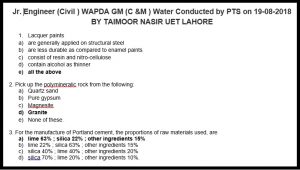WAPDA Test Questions conducted by PTS
Jr. Engineer (Civil) WAPDA GM (C&M ) Water Conducted by PTS on 19-08-2018
Shared By BY TAIMOOR NASIR UET LAHORE
Questions 1-25 out of 89
- Lacquer paints
- are generally applied on structural steel
- are less durable as compared to enamel paints
- consist of resin and nitro-cellulose
- contain alcohol as thinner
- all the above
2. Pick up the polymineralic rock from the following:
- uartz sand
- Pure gypsum
- Magnesite
- Granite
- None of these.
3. For the manufacture of Portland cement, the proportions of raw materials used, are
- lime 63% ; silica 22% ; other ingredients 15%
- lime 22% ; silica 63% ; other ingredients 15%
- silica 40% ; lime 40% ; other ingredients 20%
- silica 70% ; lime 20% ; other ingredients 10%.
4. Pick up the correct statement from the following:
- soft stones are required for carving
- light stones are required for arches
- hard stones are required to stand high pressure
- All the above.
5. The minimum water content at which the soil retains its liquid state and also possesses a small shearing strength against flowing, is known
- Liquid limit
- plastic limit
- shrinkage limit
- Permeability limit.
6. Dado is usually provided in
- dining halls
- bath rooms
- living rooms
- verandas
- roofs
7. The 9 cm x 9 cm side of a brick as seen in the wall face, is generally known as
- Stretcher
- Face
- Front
- Header
- Side
8. The under surface of an arch, is called
- Soffit
- Intrados
- Haunch
- back.
9. The process of making the back ground rough, before plastering, is
- Dubbing
- Hacking
- Blistering
- Peeling
10. The angular steps used for changing direction of the stairs, are called
- Round steps
- Angular steps
- Winders
- Radial steps
- Circular steps
11. The line of intersection of the surfaces of a sloping roof forming an external angle exceeding 180°, is
- Ridge
- Hip
- Valley
- None of these
12. A wooden block hinged on post outside a door, is known
- Cleat
- Stop
- Horn
- None of these
13. If 1500 g of water is required to have a cement paste 1875 g of normal consistency, the percentage of water is,
- 20%
- 25%
- 30%
- 35%
- 40%
14. For given water content, workability decreases if the concrete aggregates contain an excess of
- thin particles
- flat particles
- elongated particles
- flaky particles
- All the above.
15. After casting, an ordinary cement concrete on drying
- Expands
- Mix
- Shrinks
- None of these
16. Hydration of cement is due to chemical action of water with
- Tricalcium silicate and dicalcium silicate
- Dicalcium silicate and tricalcium aluminate
- Tricalcium aluminate and tricalcium alumino ferrite
- All the above.
17. Proper proportioning of concrete, ensures
- desired strength and workability
- desired durability
- water tightness of the structure
- resistance to water
- all the above
18. The bulk density of aggregates does not depend upon:
- size and shape of aggregates
- specific gravity of aggregates
- grading of aggregates
- size and shape of the container
- None of these.
19. Curing
- reduces the shrinkage of concrete
- preserves the properties of concrete
- prevents the loss of water by evaporation
- All of the above.
20. Pick up the correct proportions of chemical ingredients of cement
- Lime : Silica : Alumina : Iron oxide : 63 : 22 : 6 : 3
- Silica : Lime : Alumina : Iron oxide : 63 : 22 : 6 : 3
- Alumina : Silica : Lime : Iron oxide : 63 : 22 : 6 : 3
- Iron oxide : Alumina : Silica : Lime : 63 : 22 : 6 : 3
21. Slump test is measure of mobility ,consistency ,homogeneity, all
22. The strength and quality of concrete, depend upon:
- grading of aggregates
- surface area of aggregates
- shape of aggregates
- surface texture of aggregates
- all the above.
23. The process of mixing, transporting, placing and compacting concrete using Ordinary Port land Cement should not take more than
- 30 minutes
- 40 minutes
- 60 minutes
- 75 minutes
- 90 minutes.
24. If 50 kg of fine aggregates and 100 kg of coarse agregates are mixed in a concrete whose water cement ratio is 0.6, the weight of water required for harsh mix, is
- 8 kg
- 10 kg
- 12 kg
- 14 kg
- 15 kg
25. The bulk density of aggregates, depends upon
- Shape
- Grading
- Compaction
- all the above.
Click Here to See Questions 26-50 out of 89
Click Here to See Questions 51-70 out of 89
Click Here to See Questions 71-89
WAPDA Test Questions, WAPDA Test Questions, WAPDA Test Questions, WAPDA Test Questions, WAPDA Test Questions, WAPDA Test Questions, WAPDA Test Questions, WAPDA Test Questions, WAPDA Test Questions, WAPDA Test Questions, WAPDA Test Questions, WAPDA Test Questions, WAPDA Test Questions, WAPDA Test Questions, WAPDA Test Questions,
